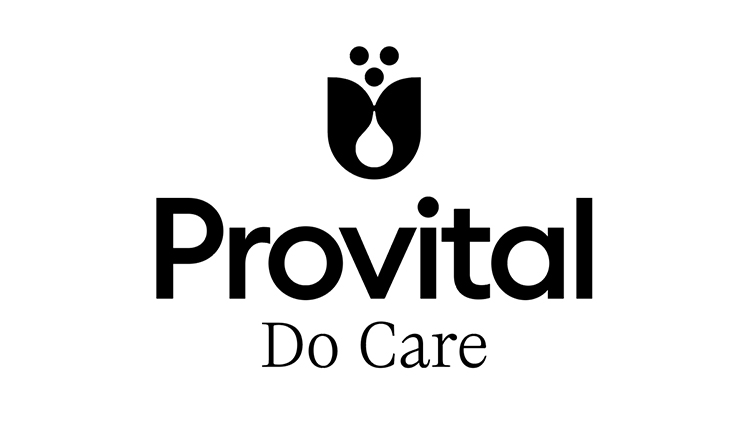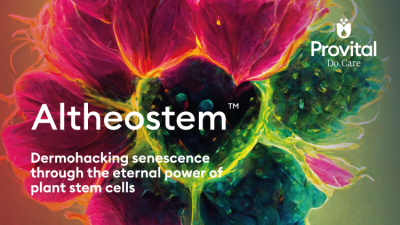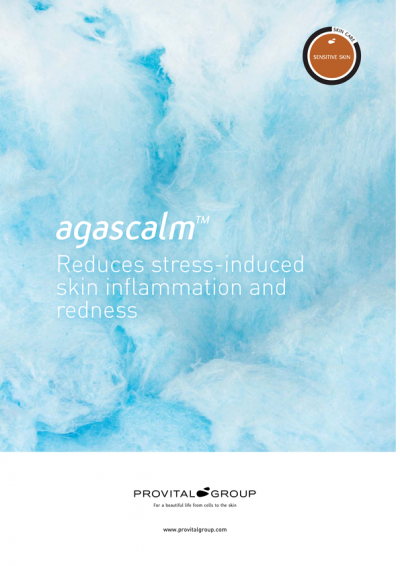Promotional Features
Cosmetic ingredients that emulate ecosystem and enhance natural skin barriers for healthy ageing
In today's dynamic global landscape, the world functions as a vast, interconnected network driven by extensive data exchanges.
Technology, trade, and communication weave an intricate web of interdependence, fostering a collective consciousness. This interconnectedness is evident in the ripple effect of environmental, economic, and social events, emphasising the need for a collaborative mindset to address global challenges.
Within the intricate fabric of ecosystems, plants, animals, and microorganisms engage in vital interkingdom symbiotic relationships, essential for overall balance and vitality. Endophytic relationships – where microorganisms reside within plant tissues – contribute significantly to ecosystem health, playing key roles in nutrient cycling, disease resistance, and stability.1 Endophytes, nestled within plants, not only bolster growth but also craft bioactive compounds, offering an eco-friendly alternative to conventional sourcing methods.
Exploring this interconnectivity between kingdoms not only unveils the delicate dynamics of the natural world but also opens a wide array of new possibilities in the cosmetic field. How? Provital believes that the presence of big data in the modern world mirrors the gene, molecule, and enzyme transfer of these interkingdom relations.
Both phenomena represent dynamic information flows that fuel innovation and adaptation. While big data enables insights and informed decisions, ecosystem symbiosis promotes genetic diversity and evolutionary resilience by facilitating the spread of advantageous genetic traits.
Interkingdom symbiosis as a new era for beauty development
Acknowledging the dynamic data transfer within natural systems underscores the importance of fostering sustainable practices that preserve the delicate balance of ecosystems. It also emphasises the profound positive impacts of nature on human wellbeing, echoing the core principles of new concepts like ecopsychology.
In line with these growing movements, and with its ‘Do Care’ values, Provital presents a range of active ingredients that designed to activate skin intelligence via using nature’s ancient wisdom. Just like in a real ecosystem, the first-of-its-kind Triplobiome™ platform integrates the power of the animal and plant kingdoms, to bring unprecedented symbiotic synergies for the development of new cosmetic ingredients.
With the goal of maintaining biodiversity – key for ecosystem balance – and preventing the use of the plant biomass needed to achieve active compounds for cosmetic purposes, Triplobiome™ Technology is a biotechnology that uses plant endophytes as a sustainable source to produce new natural, effective and powerful active ingredients.
Ingredients that act on the skin like an endophyte does in its host plant: Welcome to the new generation of ‘ecosystem ingredients’.
The first ecosystem ingredient
With Triplobiome™ Technology, Provital is now able to isolate a collection of endophytic strains and start a screening of bioactivities to select the best candidates for subsequent developments. Shiloxome™ is the first of these developments, the first ‘ecosystem ingredient’. It is a 100% traceable, eco-responsible and biotechnologically obtained cosmetic active that encompasses everything that the Triplobiome™ concept represents.
Shiloxome™ is the result of isolating endophytic yeast Kwoniella mangroviensis, found inside the bark of the cork oak (Quercus suber). Cork oak is known for its longevity and can live for several centuries. The natural function of this bark is to protect the living parts of the tree as its structure allows it to effectively serve as insulation and enhance survival. There is proof that endophytes have a positive effect on the cork oak bark by defending against pathogens, as well as its potential to adapt to climate change.2,3 Shiloxome™ takes that protective power to create a healthy-ageing active ingredient with anti-pollution and restructuring properties for the skin's protective barrier.
By standardising it in metabolites such as beta-glucan and xylitol – which have proven moisturising, anti-irritant, anti-wrinkle, wound healing, antioxidant and barrier function stimulating properties – Provital ensures the right quality standards for its healthy-ageing product.4,5
Provital has performed a non-directed Metabolomic analysis to assess the synergistic efficacy of many more active molecules obtained through the new Triplobiome™ Technology. This identified several compounds present in the K. mangroviensis ferment which were then used as raw materials to produce Shiloxome™. Among these, hydroxylated C18 fatty acids were detected, as well as other bioactive compounds such as phenyllactic acid, 5-methoxyindoleacetate and succinic acid.
These compounds possess interesting bioactive properties such as antimicrobial, antioxidant and collagen degradation inhibition.6 Interestingly, some of them (for example, phenyllactic acid and some indoleacetic acid derivatives) are well-established plant growth promoters (produced by endophytic yeast) that stimulate rapid and long-term responses in plants by regulating various developmental and physiological processes.6,7 Therefore, Shiloxome™’s restructuring effect on the skin is the result of transferring a natural endophytic protective system to the skin.
Triplobiome™ activates skin intelligence by transferring nature’s ancient wisdom contained in Shiloxome™, an incomparably shielding ingredient that, thanks to its symbiotic provenance, provides the skin with the capacity to adapt, survive and protect itself.
So, just as nature offers the most comprehensive protection to its coexisting inhabitants, Shiloxome™ creates an ecosystem that goes beyond skin protection.
Going beyond barrier care with a multi-omics approach to skin protection
Consumers are taking a holistic view of their health. In the ever-evolving landscape of skincare, enhancing the skin's natural defenses, such as the skin barrier, has become paramount, aligning with the preferences of the increasingly health-conscious consumer base.
While ceramides have long served as a cornerstone ingredient for bolstering skin barrier integrity, their enduring prominence underscores the ongoing importance of effective barrier care. However, in light of emerging trends encompassing exposome or microbiome health, the integration of a comprehensive protection in skincare products is emerging as a holistic approach.8
In the face of mounting environmental challenges and the threat of pollution in our daily lives, the demand for effective skincare solutions that provide robust protection has never been more critical. Shiloxome™ not only addresses the escalating concerns of skin health but also acts as a formidable shield against the pervasive pollutants that surround us while nurturing a harmonious relationship between nature and human health.
However, Shiloxome™’s protective efficacy is not just innovative in its symbiotic provenance, but in its efficacy testing:
- Supported by exposomics research, Shiloxome™ safeguards the skin from environmental pollutants by preserving the microbial diversity in the most superficial barrier of the skin.
- Transcriptomics data further substantiates the protective well-ageing efficacy of Shiloxome™ by stimulating crucial cellular processes in the extracellular matrix, promoting a youthful and healthy dermis.
- A breakthrough lipidomic analysis showed new lipid-enhancing mechanisms displayed by the active. Shiloxome™ actively works to replenish the lipid barrier, bolster moisture retention, and enhance the skin's elasticity and suppleness thanks to reducing the pollution-induced lipid peroxidation that prevents the necessary lipid chain elongation. So, this comprehensive in vivo analysis not only supports the restoration of a shielding function of the lipid barrier but also identifies and assesses the improved properties in the whole lipidome profile.
Therefore, Shiloxome™ orchestrates a symphony of natural elements to deliver a comprehensive multi-omics protection for the skin.
Moreover, its overall effect on mature skin was further supported by Provital’s in vivo instrumental study that quantified statistical significance in the improvement of key parameters for skin ageing such as transepidemal water loss (TEWL), brightness, isotropic microstructure, smoothness and elasticity. Conducted with a panel of 60 women aged 45-65, living in a polluted area, the study focused on addressing visible ageing effects that appear with age and after pollution damage, particularly in post-menopausal skin.
Overall, the in vitro and in vivo efficacy studies performed for Shiloxome™, prove that this is the first ecosystem ingredient that visibly combats ageing signs by enhancing the skin's natural barriers, safeguarding the skin against pollution, and making it the perfect solution to mature consumer needs, including post-menopausal skin conditions.
In essence, Shiloxome™ epitomises Provital's dedication to transformative skincare technology. With its symbiotic origin – the innovative Triplobiome™ technology – and high-tech proven efficacy, Shiloxome™ emerges as a potent ally in the pursuit of resilient and youthful skin, marking a paradigm shift in the healthy-ageing cosmetic sector.
References
1. Kumari, P.; Deepa, N.; Trivedi, P.K.; et al. (2023). Plants and endophytes interaction: a “secret wedlock” for sustainable biosynthesis of pharmaceutically important secondary metabolites. Microb Cell Fact 22, 226.
2. Eui Kim, B.; Kim, J.; Goleva, E.; et al. (2021). Particulate matter causes skin barrier dysfunction. JCI Insight.
3. Costa, D.; Tavares, R. M.; Baptista, P.; et al. (2019). The Influence of Endophytes on Cork Oak Forests Under a Changing Climate. In: Endophytes for a Growing World. Cambridge University Press; p. 250–74.
4. Salli, K.; Lehtinen, M. J.; Tiihonen, K.; et al. (2019). Xylitol's Health Benefits beyond Dental Health: A Comprehensive Review. Nutrients, 11(8), 1813.
5. Szél, E.; Polyánka, H.; Szabó, K.; et al. (2015). Anti-irritant and anti-inflammatory effects of glycerol and xylitol in sodium lauryl sulphate-induced acute irritation. Journal of the European Academy of Dermatology and Venereology : JEADV, 29(12), 2333–2341.
6. Du, B.; Bian, Z.; & Xu, B. (2014). Skin health promotion effects of natural beta-glucan derived from cereals and microorganisms: a review. Phytotherapy research : PTR, 28(2), 159–166.
7. Maki, Y.; Soejima, H.; Sugiyama, T.; et al. (2022). 3-Phenyllactic acid is converted to phenylacetic acid and induces auxin-responsive root growth in A,rabidopsis plants. Plant biotechnology (Tokyo, Japan), 39(2), 111–117.
8. McDougall, A.; Patent Insights: Connect the oral microbiome with health.
Additional references
Kumari P, Deepa N, Trivedi PK, Singh BK, Srivastava V, Singh A. Plants and endophytes interaction: a “secret wedlock” for sustainable biosynthesis of pharmaceutically important secondary metabolites. Vol. 22, Microbial Cell Factories. BioMed Central Ltd; 2023.
Keller A. FOCUS ON BARRIER SUPPORT TO IMPROVE SKIN HEALTH Skin protection expands to restore and maintain a strong barrier as consumers prioritize overall skin health [Internet]. 2023.
Hayflick L. The limited in vitro lifetime of human diploid cell strains. Exp Cell Res. 1965;37(3):614–36.
Joshua Cameron D, Tong Z, Yang Z, Kaminoh J, Kamiyah S, Chen H, et al. Essential role of Elovl4 in very long chain fatty acid synthesis, skin per-meability barrier function, and neonatal survival. Int J Biol Sci [Internet]. 2007;3.
Li W, Sandhoff R, Kono M, Zerfas P, Hoffmann V, Char B, et al. Depletion of ceramides with very long chain fatty acids causes defective skin permeability barrier function, and neonatal lethality in ELOVL4 deficient mice. Int J Biol Sci [Internet]. 2007;3.
Tawada C, Kanoh H, Nakamura M, Mizutani Y, Fujisawa T, Banno Y, et al. Interferon-γ decreases ceramides with long-chain fatty acids: Possible involvement in atopic dermatitis and psoriasis. Journal of Investigative Dermatology. 2014;134(3):712–8.
Janssens M, Van Smeden J, Gooris GS, Bras W, Portale G, Caspers PJ, et al. Increase in short-chain ceramides correlates with an altered lipid organization and decreased barrier function in atopic eczema patients. J Lipid Res. 2012 Dec;53(12):2755–66
Kendall AC, Pilkington SM, Wray JR, Newton VL, Griffiths CEM, Bell M, et al. Menopause induces changes to the stratum corneum ceramide profile, which are prevented by hormone replacement therapy. Sci Rep. 2022 Dec 1;12(1).
Eui Kim B, Kim J, Goleva E, Berdyshev E, Lee J, Vang KA, et al. Particulate matter causes skin barrier dysfunction. 2021; Available from:
Costa D, Tavares RM, Baptista P, Lino-Neto T. The Influence of Endophytes on Cork Oak Forests Under a Changing Climate. In: Endophytes for a Growing World. Cambridge University Press; 2019. p. 250–74.
Salli K, Lehtinen MJ, Tiihonen K, Ouwehand AC. Xylitol’s health benefits beyond dental health: A comprehensive review. Vol. 11, Nutrients. MDPI AG; 2019.
Szél E, Polyánka H, Szabõ K, Hartmann P, Degovics D, Balázs B, et al. Anti-irritant and anti-inflammatory effects of glycerol and xylitol in sodium lauryl sulphate-induced acute irritation. Journal of the European Academy of Dermatology and Venereology. 2015 Dec 1;29(12):2333–41.
Du B, Bian Z, Xu B. Skin health promotion effects of natural Beta-Glucan derived from cereals and microorganisms: A review. Vol. 28, Phytotherapy Research. 2014. p. 159–66.
Maki Y, Soejima H, Sugiyama T, Watahiki MK, Sato T, Yamaguchi J. 3-Phenyllactic acid is converted to phenylacetic acid and induces auxin-responsive root growth in Arabidopsis plants. Plant Biotechnology. 2022;39(2):111–7.
Limtong S, Kaewwichian R, Yongmanitchai W, Kawasaki H. Diversity of culturable yeasts in phylloplane of sugarcane in Thailand and their capability to produce indole-3-acetic acid. World J Microbiol Biotechnol. 2014 Jun 19;30(6):1785–96.
McDougall A. PATENT INSIGHTS: CONNECT THE ORAL MICROBIOME WITH HEALTH [Internet]. 2023.







